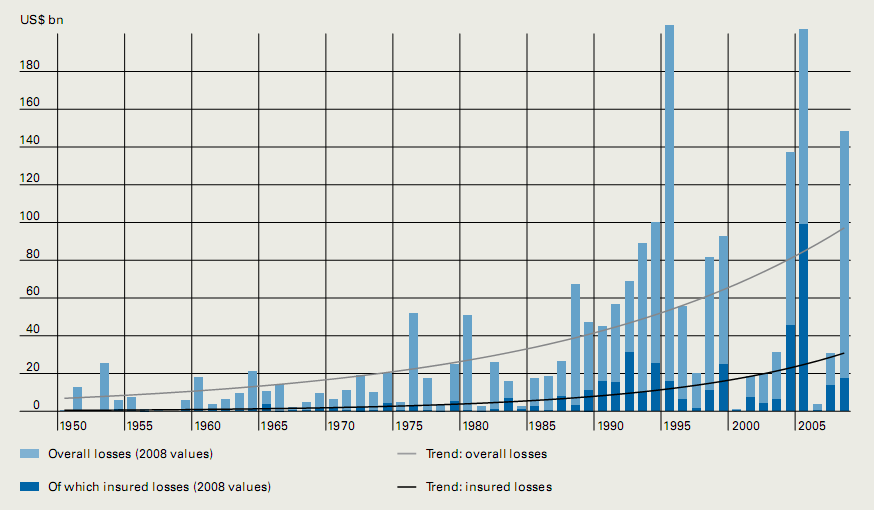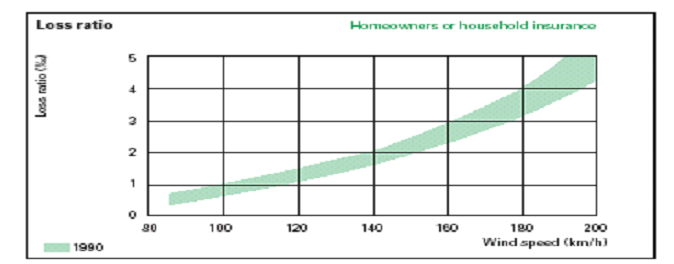|
|
|||
| |
|||
|
|
|||
Weather and Insurance
The
information contained here provides an overview of my research in this
area. A more detailed account of this research can found in my PhD thesis (18MB), and
references therein.
- Recent UK windstorm Events
- The Great Storm (16th October 1987)
- The Burns' Day Storm (25th January 1990)
- Windstorm Erwin (8th January 2005)
- Windstorm Kyrill (19th January 2007)
- Catastrophe
Modelling
- How are the costs of weather events estimated?
- Climate Change and the Insurance Industry
- What's the current position of the industry?
- To what can we attribute increasing losses?
- Can we predict future losses?
One
of the cornerstones of the (re)insurance industry is the managing of
the risk associated with natural hazards, such as earthquakes and
flooding. Insuring against adverse effects of weather is a core
business. Increasingly, weather related events are dominating not only
the news, but also losses to global non-life insurers.
Worldwide, the costs of catastrophic weather events have increased dramatically in recent years, as shown in Figure 1. Insured losses have risen from a negligible level in 1950 to an annual figure exceeding $10bn in the 21st century. When losses from non-catastrophic weather related events are included this figure is doubled. The trend exhibited is influenced by economic, demographic and geographic shifts and well as natural factors. Three quarters of the most expensive 40 insured losses of all time were windstorm related.

Figure 1 - Worldwide
annual economic and insured losses from large events. Click
on image to open in a new window.
The
magnitude of losses associated with weather related catastrophes can
carry
serious economic consequences for the region and people affected, the
political
body responsible for that region as well as the insurance industry. All
three
parties have a vested interest in managing the risk posed by severe
weather
events, and mitigating against them. One of the keys of risk management
is the
identification and analysis of the risk. Catastrophe modelling is a
tool that
provides a thorough analysis of the risk, in this case a thorough
understanding
of the potential impact of weather events at a certain location.
Generally,
a catastrophe model is comprised of four modules; hazard, exposure,
vulnerability and loss. The hazard
module contains information on the nature of the weather event,
incorporating
such things as storm track, intensity and duration. Within the exposure
module
details of the type of properties at risk are stored, including
building
specifications and age. The third module, vulnerability, is key to
producing a
realistic catastrophe model. Hazard and exposure are combined to
produce a
vulnerability curve, which describes the expected damage for a given
magnitude
or intensity of hazard. A fourth component, loss, is usually employed
by the
insurers, and incorporates the vulnerability curve and policy
conditions, to
produce estimates of insured loss.
Generally,
insurers make underwriting decisions for risks of economic losses based
on information from historical events. Should the pattern of these
events be altered, such as a shift in climate, then the basis of these
decisions is changed. Owing to this fact, within the finance sector,
insurers have been prominent in addressing the climate change issue.
However, the short-term nature of insurance means that the topic of
potential climate change is met with some scepticism within certain
sectors of the industry.
Franklin Nutter, president, Reinsurance Association of America in a statement to Congress April 1998
The insurance industry could be put under considerable strain due to shifting patterns of extreme weather events driven by climate change. The following table lists potential changes in extremes and their effect on the Insurance industry.
| Climatic Change | Effect on Insurance Industry |
| Higher maximum temperatures, more hot days and heat
waves over nearly all land areas |
Increasing numbers of heat waves and droughts will affect health, life, crop, property, business interruption lines. |
| More intense precipitation events | Increased flooding, in particular flash flooding, will effect property, flood, vehicle, business interruption, life, health lines. |
| Increased summer drying | Risk of drought grows and subsidence and wildfire events increases, impacting property, life, health lines. |
| Increased intensity of mid-latitude storms | Windstorm damage increases effecting property, flood, vehicle, business interruption, life, health insurance. |
A
report by the Association of British Insurers (ABI), "A
Changing Climate for Insurers" concluded:
Increasing Losses
Insurance costs have been rising globally since 1970s (as shown in Figure 1), essentially due to increases in population in regions that are at risk, but also in part to the increase in frequency and severity of certain forms of extreme weather events. It is very difficult to disentangle the socio-economic impacts (such as increasing population, increasing population density in high risk areas, increasing wealth, land use change etc) and natural factors (such as changing patterns of extreme weather).
Global weather-related losses in recent years have been trending upwards much faster than population, GDP, premiums, non-weather related events. Some studies attribute this solely to increased vulnerability, but these studies often overlook the fact that human actions mask losses that would otherwise manifest (such as improved building codes, early warning systems, flood control, crop irrigation, etc).
Overall, the attribution of the increasing trend of insured loss from weather events has not been dealt with in the literature satisfactorily. However, future changes in the severity and frequency of extreme weather events are likely to accelerate the current trend, impacting further on the insurance industry.
The Stern Review on the economics of climate change concluded that....- "The costs of extreme weather events are already high and rising, with annual losses of around $60 billion since the 1990s (0.2% of World GDP), and record costs of $200 billion in 2005 (more than 0.5% of World GDP). New analysis based on insurance industry data has shown that weather-related catastrophe losses have increased by 2% each year since the 1970s over and above changes in wealth, inflation and population growth/movement. If this trend continued or intensified with rising global temperatures, losses from extreme weather could reach 0.5 - 1% of world GDP by the middle of the century. If temperatures continued to rise over the second half of the century, costs could reach several percent of GDP each year, particularly because the damages increase disproportionately at higher temperatures."
Quantifying future losses
Consensus
in the scientific
world is that climate change is a reality for this and future
generations
(IPCC, 2007). Any shifts in
the frequency
and intensity of extreme events, associated with climate change, will
have a
direct effect on general insurance, with the greatest impact being on
property
insurance.

Figure 2 - Household insurance loss
ratios in Great Britain, at various windspeeds recorded in the January
and February 1990 storms.
Source: Munich Re (2002)
This illustrates the danger to the insurance industry; a small shift in
climate (such as a slight increase in peak gust speed in storms) could
have a
dramatic impact on insured losses.
The
insurance industry finds itself in a unique position with regard to
climate change. On the one hand the potential affect of a shifting
climate
could result in significant financial losses. On the other hand the
nature of
insurers as risk assessors means they are ideally place to evaluate
these
impacts. Pre-existing tools, such as catastrophe models, can be adapted
to
estimate losses in future climates.
Recent
hurricane losses in
IPCC (2007). Climate Change 2007: Impacts, Adaptation and
Vulnerability. Contribution of Working Group II to the Fourth
Assessment Report of the Intergovernmental Panel on Climate Change.
M.L. Parry, O.F. Canziani, J.P. Palutikof, P.J. van der Linden and C.E.
Hanson (Eds). Cambridge, UK: 976.
McGhee, C., R. Clarke
and
J. Collura (2007). The Catastrophe Bond Market at
Year-End 2006, MMC Securities: 42.
 This
page was last updated on
20th October 2009. Every effort is made to ensure links from this page
are still active; however, if you find they are not please let me know.
This
page was last updated on
20th October 2009. Every effort is made to ensure links from this page
are still active; however, if you find they are not please let me know.
